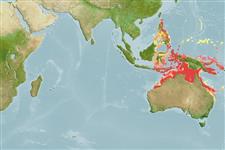Environment: milieu / climate zone / depth range / distribution range
Ecologie
marien rifbewoner; diepte 5 - 100 m (Ref. 6390). Tropical; 21°N - 28°S, 117°E - 159°E (Ref. 5222)
Western Pacific: Thailand, Singapore, Philippines, Indonesia, Papua New Guinea, the Arafura Sea (Ref. 9819), Solomon Islands, and Australia (from Houtman Abrolhos in Western Australia to Gladstone, Queensland) (Ref. 3150). This species was formerly listed as occurring in the western Indian Ocean based on a misidentification of Plectropomus pessuliferus.
Lengte bij maturiteit / Grootte / Gewicht / Leeftijd
Maturity: Lm ? range ? - ? cm
Max length : 125 cm TL mannelijk / geslacht onbekend; (Ref. 90102); max. gepubliceerd gewicht: 25.0 kg (Ref. 5222)
Dorsale stekels (totaal): 7 - 8; Dorsale zachte stralen (totaal): 10-12; Anale stekels 3; Anale zachte stralen: 8.
Found in protected coastal reef in mixed algae and coral habitat (Ref. 48635). Common on inshore coastal reefs but absent in clear offshore reefs (Ref. 9710). Juveniles have a demersal existence in shallow water in reef habitats, especially around coral rubble (Ref. 27259). Migrate over short distances to spawn, forming aggregations (Ref. 6390). May move into shallow water to feed (Ref. 6390). Eggs float just below the water surface (Ref. 6390). Pelagic larvae are found in habitats similar to those of the adults (Ref. 27260). Juveniles feed on small fish and invertebrates such as crustaceans and squid (Ref. 27261). Commonly used for food. Its flesh is delicate and well appreciated (Ref. 5503). Solitary (Ref 90102).
Confirmed for diandry (Ref. 103751).
Heemstra, P.C. and J.E. Randall, 1993. FAO Species Catalogue. Vol. 16. Groupers of the world (family Serranidae, subfamily Epinephelinae). An annotated and illustrated catalogue of the grouper, rockcod, hind, coral grouper and lyretail species known to date. Rome: FAO. FAO Fish. Synop. 125(16):382 p. (Ref. 5222)
Status op de Rode Lijst van het IUCN (Ref. 130435)
Gevaar voor de mens
Reports of ciguatera poisoning (Ref. 30298)
Gebruik door de mens
Visserij: commercieel; Aquacultuur: commercieel; sportvis: ja
Meer informatie
ReferentiesAquacultuurAquacultuurprofielKweeklijnenGeneticaElectrophoresesErfelijkheidZiektesVerwerkingNutrientsMassaconversie
Tools
Speciale rapporten
Download XML
Internetbronnen
Estimates based on models
Preferred temperature (Ref.
123201): 26.1 - 28.8, mean 27.8 °C (based on 466 cells).
Fylogenetische diversiteitsindex (Ref.
82804): PD
50 = 0.5078 [Uniqueness, from 0.5 = low to 2.0 = high].
Bayesian length-weight: a=0.01122 (0.00581 - 0.02169), b=3.05 (2.89 - 3.21), in cm total length, based on LWR estimates for this species & (Sub)family-body (Ref.
93245).
Trofisch niveau (Ref.
69278): 4.1 ±0.70 se; based on food items.
Weerstandsvermogen (Ref.
120179): Gemiddeld, minimale populatieverdubbelingstijd 1,4-4,4 jaar (K=0.21; tm=2-3).
Fishing Vulnerability (Ref.
59153): Moderate to high vulnerability (51 of 100).
Nutrients (Ref.
124155): Calcium = 20.9 [13.3, 35.2] mg/100g; Iron = 0.483 [0.267, 0.780] mg/100g; Protein = 18.7 [16.9, 20.3] %; Omega3 = 0.133 [0.089, 0.206] g/100g; Selenium = 47.8 [28.7, 84.8] μg/100g; VitaminA = 75.7 [28.7, 229.0] μg/100g; Zinc = 0.7 [0.5, 1.0] mg/100g (wet weight);
